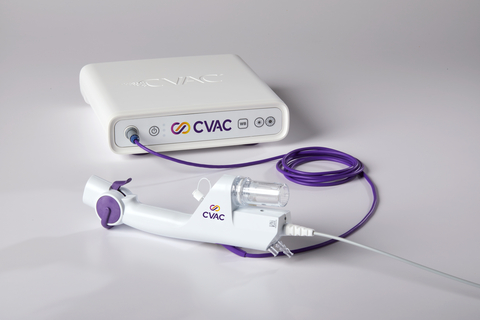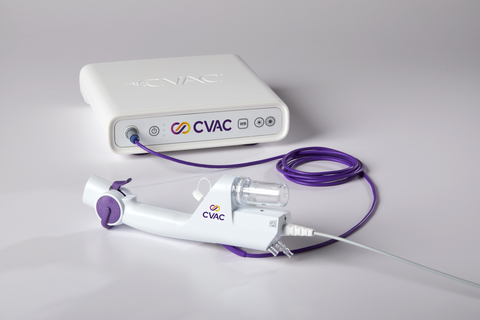PLEASANTON, Calif.--(BUSINESS WIRE)--Calyxo, Inc., a medical device company developing innovative solutions for patients with kidney stones, announces positive new study results for its CVAC System in kidney stone clearance. The new data show that healthcare consumption (HC) events including emergency department (ED) visits, hospitalization and retreatment were significantly lower after steerable ureteroscopic renal evacuation (SURE) with the CVAC System compared to ureteroscopy (URS). The new 1-year multi-center ASPIRE study results, along with other key CVAC System data, were presented at the 41st World Congress of Endourology and Uro-Technology (WCET) in Seoul, South Korea, August 12-16, 2024.
“The ASPIRE 1-year data shows significantly lower cumulative incidence of HC events after SURE compared to standard URS,” said Dr. Karen L. Stern, urologist at the Mayo Clinic Arizona and presenter of the study results. “This new data suggests that the new CVAC System may have the potential for a positive clinical and health economic impact in the treatment of urolithiasis,” she added.
The treatment of kidney stones in the United States continues to be a growing challenge with its prevalence increasing from 3.8% in the late 1970s to 11% in 2021.1 In addition, studies have reported that an estimated 23% of patients needed retreatment during the first year following URS.2
The SURE procedure is exclusively performed with the CVAC System and is the only complete stone clearance solution that enables effective and efficient kidney stone removal. It is an all-in-one system that integrates ureteroscopy, laser lithotripsy, irrigation, aspiration, and stone collection.
The multi-center ASPIRE study is a prospective, randomized study comparing the safety and efficacy of the SURE approach with the CVAC System vs standard URS with basketing in 123 patients.
At 12 months, the ASPIRE study showed that HC events are significantly lower after SURE compared to URS:
- 123 subjects were randomized and 101 qualified for the efficacy analysis (SURE 46 vs URS 55).
- The 12-month subject retention was 95%.
- At 1-year, the cumulative incidence of HC events was significantly lower for SURE versus URS (3 HC events in 2 subjects vs 14 HC events in 9 subjects, p=0.015).
- Kaplan-Meier analysis demonstrated that by 12 months, 95.6% of SURE subjects were free of HC events versus 83.5% for URS subjects.
Additional data presented at WCET showed:
Initial Experience with the Second Generation CVAC Aspiration System; Outcomes of Multi- Center Market Research – Dr. Brian Eisner, Massachusetts General Hospital, Harvard Medical School)
In this initial case experience, 50 urologists from 23 academic and private institutions completed 174 SURE procedures with the new CVAC System. The median stone burden was 15 mm with no stone burden limit in the study. They found the new-generation CVAC System achieved high stone clearance per intraoperative visual assessment (81% of cases demonstrated >95% stone clearance rate) with improved ease of use. Top performance attributes included passive aspiration of dust during laser lithotripsy, active aspiration of larger fragments, direct visualization, and all-in-one capability of the system.
Safety and Feasibility of the Steerable Ureteroscopic Renal Evacuation Device, A Single Center Experience – Dr. Luke Griffiths, Smith Institute for Urology, Northwell Health
Single center retrospective chart review of all patients (n=91) who underwent SURE January 2022 through August 2023. The study showed that SURE with the CVAC System is a safe and effective treatment option for patients undergoing URS with high stone free rate comparable to URS alone. In addition, SURE with the CVAC System was associated with low morbidity even with treating large volume stone disease.
Case presentation of the new CVAC System: Is it going to change the game?!
A video case with Dr. Isaac Palma-Zamora, UT Southwestern Medical Center will also be featured during WCET on Wednesday, August 14, 2024, starting at 14:00.
“These important results presented during WCET further advance and confirm earlier data showing that the SURE approach with the CVAC System is safe and provides better stone clearance compared to standard URS,” said Joe Catanese, PhD, Calyxo’s President & CEO. “We are continuing to work with urologists, endourologists and the healthcare community to raise awareness about our new FDA-cleared CVAC System and how it can help improve outcomes for patients with kidney stones,” he added.
For more information about the newly FDA-cleared CVAC System, please visit: Calyxo, Inc.
About the CVAC System
The new CVAC System was recently FDA-cleared and enables a minimally invasive approach for kidney stone clearance. It is an all-in-one solution that is designed to efficiently and effectively remove kidney stones. It uses irrigation and vacuum aspiration to continuously clear stone fragments during and after laser lithotripsy, enabling physicians to achieve a stone-free outcome.
About Calyxo, Inc.
Calyxo, Inc. is an innovation-driven medical device company focused on improving care for patients with kidney stones by delivering paradigm-shifting solutions that enable urologists to safely, effectively and efficiently achieve unrivaled clinical outcomes. Learn more at calyxoinc.com.
FOR MORE INFORMATION:
Study investigators and presenters are available to discuss further. For more information and to schedule interviews, please contact:
Alyssa Paldo
Alyssa.paldo@finnpartners.com
M: +1 847 791 8085
1 Kidney stones. National Kidney Foundation. (2024, July 22). https://www.kidney.org/atoz/content/kidneystones
2 Johnston SS, Chen BP, Rai P, Grange P, Dwarakanathan HR, Amos T, Johnson BH, Ghosh SK, Buchholz N. Incremental Healthcare Cost Implications of Retreatment Following Ureteroscopy or Percutaneous Nephrolithotomy for Upper Urinary Tract Stones: A Population-Based Study of Commercially-Insured US Adults. Med Devices (Auckl). 2022 Nov 10;15:371-384. doi: 10.2147/MDER.S384823. PMID: 36389203; PMCID: PMC9662022.





